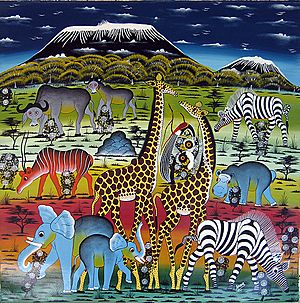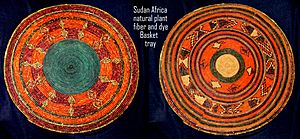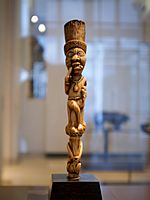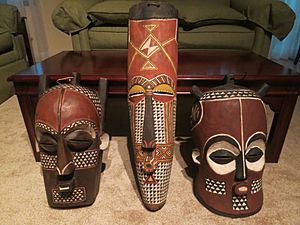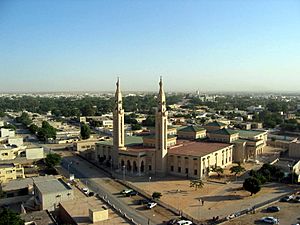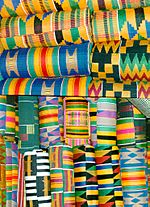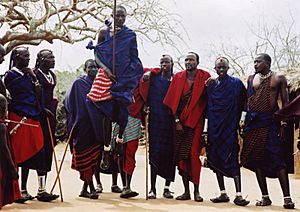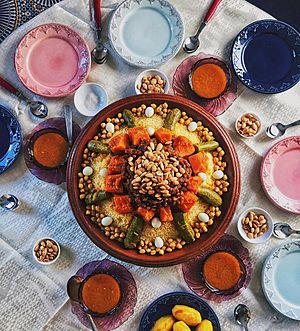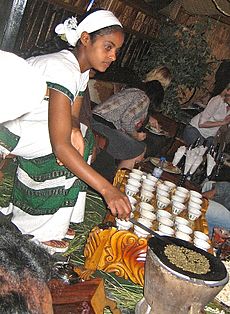Culture of Africa facts for kids
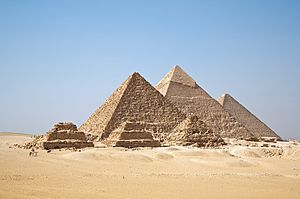
The Culture of Africa is incredibly rich and diverse. It's like a huge puzzle made of many unique pieces! Africa is a continent with many countries and different groups of people, called tribes or ethnic groups. Each group has its own special way of life.
Culture means all the unique things that belong to a group of people. This includes their laws, beliefs, knowledge, art, and customs. It also covers their languages, favorite foods, greetings, and dances. Even though African cultures are very different, they also share many things. For example, most African cultures value strong family ties and respect for elders. They also deeply love and respect their own traditions.
Africa's culture has both influenced and been influenced by other parts of the world. Many African countries today encourage their traditional dances, music, and art. They want to keep their rich heritage alive.
Contents
A Look at History
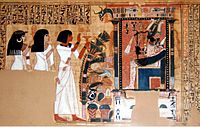
Africa has many different ethnic cultures. Over time, different groups from outside Africa have also influenced its cultures. For example, during the time of the Roman Empire, parts of North Africa became very wealthy. Later, during the time of European colonization, some European countries tried to make Africans give up their own cultures and adopt European ways.
However, many Africans worked hard to bring back and celebrate their traditional cultures. Today, many African nations work to protect and promote their unique cultural heritage.
African Arts and Crafts
Africa is famous for its amazing arts and crafts. You can find beautiful woodcarvings, brass items, and leather artwork. African art also includes sculptures, paintings, pottery, and special headgear for ceremonies.
Many African artworks are not just pretty to look at. They often have a deeper meaning or purpose. For example, some art is made to bring about positive change or to inspire people.
Personal appearance is very important in many African cultures. Jewelry is a popular accessory, often made from cowry shells or similar materials. Masks are also a big part of some cultures. These masks have detailed designs and are used in ceremonies. They can represent ancestors, spirits, or characters from myths.
Many traditional African arts share common themes. You might see sculptures of a couple, a woman with a child, or a man with a weapon. These themes often represent important ideas like family, community, honor, or power.
Folklore and Religion
African folklore and religion are very diverse, just like the cultures themselves. In many parts of Africa, culture and religion are closely connected. For example, in Ethiopia, Christianity and Islam are central to the culture. They influence food customs and special ceremonies.
Folktales are also very important in many African cultures. These stories help to preserve a group's cultural identity and history. Storytelling often creates a sense of belonging within a community. For outsiders, these stories offer a peek into the beliefs and customs of the group.
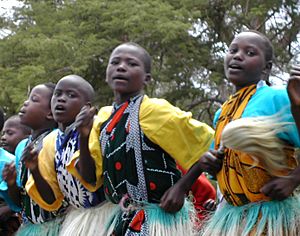
Folktales are used for both education and entertainment. They teach important lessons, like how good wins over evil. They also show that human desires and fears, like love and loss, are common to all cultures. Many stories feature talking animals or magical events.
There are different kinds of African stories. Animal tales are often for fun but still teach lessons. The Hare is usually the clever trickster, while the Hyena is often tricked. Birds are usually the messengers. Day-to-day tales are more serious. They talk about everyday life and challenges, like famine or family issues. These stories often include songs at important moments.
African storytelling often follows a special structure. Villagers might gather at the end of the day to share stories. Storytellers use special phrases to begin and end a tale. They might also use instruments like drums to make sounds. Repetition and call-and-response are used to get the audience involved.
Clothes

Traditional clothes in Ethiopia for women are often made from a fabric called schema. This is used to make the habesha kemis, a white outfit that is a national costume. Other groups, like the Oromo people, wear leather garments. The Afaris wear brightly colored cotton wraps. The habesha kemis is made from cotton strips sewn together. Sometimes shiny threads are added for a fancy look.
Men in Ethiopia wear pants and a knee-length shirt with a white collar. They might also wear a sweater and knee-high socks. Both men and women wear shawls called netela.
The Zulus of Southern Africa wear different outfits for ceremonies. The ibheshu is a rear piece made of animal hide. Its length can show a man's age or social status. Older men wear longer amabheshu. Married men often wear a headband called an umqhele, also made of animal hide. Zulu men also wear cow tails as bracelets and anklets for special events.
In Muslim parts of Africa, daily clothes often follow Islamic traditions. Men usually cover their heads and the area from their waist to their knees. Women's clothes are designed to cover their hair and body from neck to ankles. Some Muslim women also cover their faces.
Cuisine
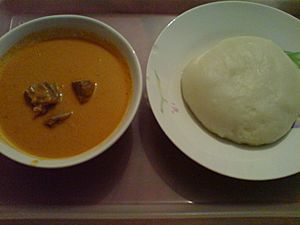
African cuisines use many local ingredients. These include fruits, grains, vegetables, milk, and meat. In some areas, people eat a lot of milk products. But in many tropical parts of Africa, cow's milk is rare. Africa's many different groups mean there are lots of different eating habits and dishes.
In Central Africa, common foods are plantains and cassava. Fufu, a starchy food made from cassava, is eaten with grilled meat and sauces. Many dishes use local ingredients like spinach stew, cooked with tomatoes, peppers, and peanut butter. Cassava leaves are also eaten as greens. Peanut stew with chicken and okra is another favorite. People also enjoy Bambara, a porridge of rice, peanut butter, and sugar. Beef and chicken are popular, but sometimes people eat game meats like crocodile or antelope.
The food in the African Great Lakes region varies. In some areas, people who raise cattle don't eat much meat. Cattle are seen as a form of wealth. Instead, they might drink milk and blood from the cattle. Other groups are farmers who grow grains and vegetables. Ugali, made from corn, is a staple food in East Africa. It's like West Africa's fufu and is eaten with meats or stews. In Uganda, steamed green bananas called matoke are a common starchy food.
In the Horn of Africa, main dishes in Ethiopian cuisine and Eritrean cuisine are tsebhis (stews). These are served with injera, a flatbread made from teff. Somali cuisine mixes many influences. Bariis (rice), especially basmati, is often the main dish. Xalwo (halva) is a sweet treat for special events like weddings. After meals, homes are often perfumed with frankincense. All food is prepared halal, meaning it follows Islamic dietary rules.
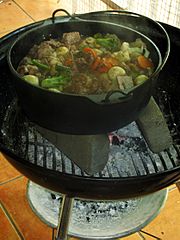
North African cuisine has roots in ancient empires like Egypt. Traders, travelers, and immigrants have all influenced the food over centuries. Many North African countries share similar dishes, sometimes with different names. For example, a Moroccan tangia and a Tunisian coach are both meat stews cooked overnight. Moroccan food is known for its rich flavors, while Tunisian dishes can be spicy.
The food of Southern Africa is called 'rainbow cuisine' because it blends many traditions. These include foods from the Khoisan, Bantu, European, and Asian groups. Common ingredients are seafood, meats (including wild game), poultry, grains, and fresh fruits and vegetables. Fruits like apples, grapes, mangoes, and oranges are popular. Desserts can be simple fruit or more Western-style puddings. Meats include lamb, venison, ostrich, and impala. Seafood like crayfish, prawns, and tuna are also eaten. Many European-style beers are popular alcoholic drinks.
A typical West African meal often has starchy foods, meat, and spices. Staples include Fufu, Banku, Kenkey, Couscous, and Garri. These are served with soups and stews. Fufu is made from root vegetables like yams or cassava. The main grain or starch changes from region to region. Corn is now very popular because it's cheap and makes a nice white product. Rice dishes are also widely eaten, especially in the dry Sahel region. Examples include Benachin from The Gambia and Jollof rice, a popular rice dish across West Africa.
African Music

Traditional music in Sub-Saharan Africa is very diverse. Many people think of African music as being all about drums and rhythm, and a lot of it is! Music from groups like the Niger-Congo and Nilo-Saharan speakers often uses many drums and has complex, layered rhythms (polyrhythms). Dancing often involves moving many parts of the body at once. These musical styles traveled to the Americas with enslaved West Africans. They influenced music like Samba, Jazz, Rhythm and Blues, Rock & Roll, Salsa, and Rap music.
Other African music traditions use string instruments and horns. Music from the eastern Sahel and along the Nile often featured strings and horns long ago. Dancing in these areas might involve swaying body movements and footwork. The Khoisan people also use string instruments and focus on footwork in their dances.
Modern Sub-Saharan African music has been influenced by music from the Americas. Popular styles include Mbalax from Senegal, Highlife from Ghana, and Soukous from the Democratic Republic of Congo. New World styles like Salsa, R&B, Reggae, and Zouk are also very popular.
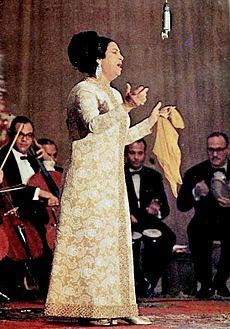
Music from North Africa, the Nile Valley, and the Horn of Africa is closely related to Middle Eastern music. It uses similar musical scales called maqamat. This music ranges from ancient Egyptian styles to the music of desert nomads like the Berbers and Tuareg. Popular modern styles include Raï from Algeria. Somali music often uses a five-note scale (pentatonic). In Ethiopia, the Amhara music uses a special system of modes called qenet, with four main types: tezeta, bati, ambassel, and anchihoy.
Languages
Africa is home to about one-third of all the world's languages! There are between 1,000 and 2,000 different languages spoken on the continent. These languages belong to a few main families:
- Afro-Asiatic languages: Around 200 languages, found mostly in North Africa, including the Horn of Africa.
- Niger–Congo languages: The largest language family in the world, with about 1,350 to 1,650 languages. These are spoken across West, Central, East, and Southern Africa, and include the Bantu languages.
- Nilo-Saharan languages: About 140 languages, found in parts of the Sahara, Sahel, and East Africa.
- Khoisan languages: The smallest and possibly oldest family, with 40 to 70 languages. These are mainly spoken by indigenous groups in Southern Africa.
Not all languages are spoken by the same number of people. Some are spoken by only a few hundred, while others are spoken by millions. The most widely spoken African languages include Swahili (100 million speakers), Hausa (38 million), Yoruba (20 million), Amharic (20 million), Igbo (21 million), and Fula (13 million). Most of these belong to the Niger-Congo family.
Many African countries use several official languages, including both African and European languages. Some Africans speak European languages like English, French, Portuguese, or Spanish. The African Union uses Arabic, English, French, Portuguese, Spanish, Kiswahili, and any other African language as its official languages.
African Diaspora
African cultures have also had a huge impact on the rest of the world. This happened through West African cultural traditions that were brought to the Americas and the Caribbean during the Trans-Atlantic Slave Trade. Later, people from all over Africa also moved to other parts of the world, bringing their cultures with them.
See also
 In Spanish: Cultura de África para niños
In Spanish: Cultura de África para niños
- History of Africa
- Sub-Saharan Africa
- Culture of Asia
- Culture of Europe
- Culture of North America
- Culture of Oceania
- Culture of South America



